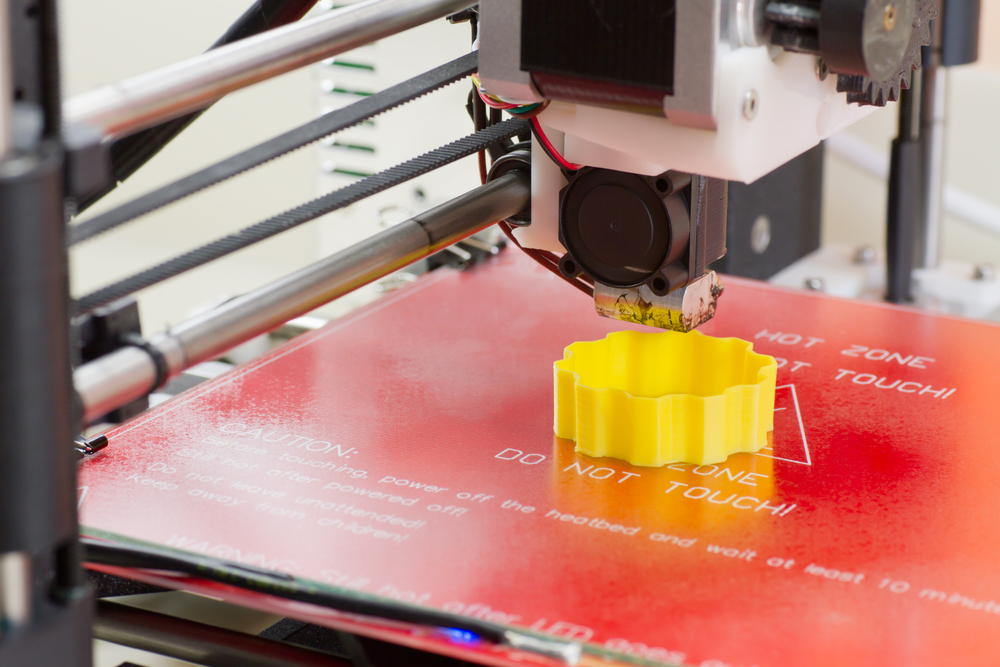 Is 3-D printing dead? John Brandon, a contributing editor to Inc., certainly thinks the format is dying. In a new article, he breaks down the reasons why 3-D printing (in his opinion) is on life support, ranging from pricing to a lack of potential applications. For example, the cost of materials is prohibitive; why spend more than $60 on the polymer filament necessary to print something small and relatively simple, like a water-bottle cage, when you can purchase the finished product online for a fraction of the price? Brandon isn’t the only one drafting 3-D printing’s obituary. Earlier this month, Newsweek published an article suggesting that the 3-D printing industry’s “bubble” may have burst. The stock price of two prominent 3-D printing firms, 3D Systems and Stratasys, have tumbled over the past two years; and despite some early hype, low-cost 3-D printers haven’t become ubiquitous. “You can only make so many lime-green Yoda heads before you get a little bored and wonder, ‘Why did I buy this 3-D printer?’” Tim Caffrey, a senior consultant with consulting firm Wohlers Associates, told Newsweek. Nonetheless, some pundits and analysts still hold out hope that 3-D printing will take off. Research firm Gartner, for example, predicts that the healthcare and manufacturing industries will rely on 3-D printing to create a significant percentage of products, including devices that patients embed in their bodies, within the next four years; the firm also thinks that shipments of 3-D printers will hit 5.6 million per year by 2019. As even Brandon concedes, rapid prototyping—in which firms print out 3D models of products for future production—is alive and well. From Ford to Apple, companies rely on this custom printing to create new parts and figure out problems. But there’s a huge difference between multi-million dollar machines capable of churning out highly complex one-offs, and the cheaper 3-D printers that many in the industry believed would revolutionize how we create and repair household and small-business items. Unlocking the potential of 3-D printers as personal devices may come down to reliability and cost; when people can build a variety of useful, sturdy products for a small percentage of what those same products would have cost them in a store, adoption may rise. Barring that, however, the future of 3-D printing could hinge on small businesses turning to it as an alternative means of manufacturing. 3-D printing isn’t dead, but the industry may need to undergo a radical adjustment if it wants to fulfill its early, revolutionary promise.
Is 3-D printing dead? John Brandon, a contributing editor to Inc., certainly thinks the format is dying. In a new article, he breaks down the reasons why 3-D printing (in his opinion) is on life support, ranging from pricing to a lack of potential applications. For example, the cost of materials is prohibitive; why spend more than $60 on the polymer filament necessary to print something small and relatively simple, like a water-bottle cage, when you can purchase the finished product online for a fraction of the price? Brandon isn’t the only one drafting 3-D printing’s obituary. Earlier this month, Newsweek published an article suggesting that the 3-D printing industry’s “bubble” may have burst. The stock price of two prominent 3-D printing firms, 3D Systems and Stratasys, have tumbled over the past two years; and despite some early hype, low-cost 3-D printers haven’t become ubiquitous. “You can only make so many lime-green Yoda heads before you get a little bored and wonder, ‘Why did I buy this 3-D printer?’” Tim Caffrey, a senior consultant with consulting firm Wohlers Associates, told Newsweek. Nonetheless, some pundits and analysts still hold out hope that 3-D printing will take off. Research firm Gartner, for example, predicts that the healthcare and manufacturing industries will rely on 3-D printing to create a significant percentage of products, including devices that patients embed in their bodies, within the next four years; the firm also thinks that shipments of 3-D printers will hit 5.6 million per year by 2019. As even Brandon concedes, rapid prototyping—in which firms print out 3D models of products for future production—is alive and well. From Ford to Apple, companies rely on this custom printing to create new parts and figure out problems. But there’s a huge difference between multi-million dollar machines capable of churning out highly complex one-offs, and the cheaper 3-D printers that many in the industry believed would revolutionize how we create and repair household and small-business items. Unlocking the potential of 3-D printers as personal devices may come down to reliability and cost; when people can build a variety of useful, sturdy products for a small percentage of what those same products would have cost them in a store, adoption may rise. Barring that, however, the future of 3-D printing could hinge on small businesses turning to it as an alternative means of manufacturing. 3-D printing isn’t dead, but the industry may need to undergo a radical adjustment if it wants to fulfill its early, revolutionary promise. Is 3-D Printing Dying?
 Is 3-D printing dead? John Brandon, a contributing editor to Inc., certainly thinks the format is dying. In a new article, he breaks down the reasons why 3-D printing (in his opinion) is on life support, ranging from pricing to a lack of potential applications. For example, the cost of materials is prohibitive; why spend more than $60 on the polymer filament necessary to print something small and relatively simple, like a water-bottle cage, when you can purchase the finished product online for a fraction of the price? Brandon isn’t the only one drafting 3-D printing’s obituary. Earlier this month, Newsweek published an article suggesting that the 3-D printing industry’s “bubble” may have burst. The stock price of two prominent 3-D printing firms, 3D Systems and Stratasys, have tumbled over the past two years; and despite some early hype, low-cost 3-D printers haven’t become ubiquitous. “You can only make so many lime-green Yoda heads before you get a little bored and wonder, ‘Why did I buy this 3-D printer?’” Tim Caffrey, a senior consultant with consulting firm Wohlers Associates, told Newsweek. Nonetheless, some pundits and analysts still hold out hope that 3-D printing will take off. Research firm Gartner, for example, predicts that the healthcare and manufacturing industries will rely on 3-D printing to create a significant percentage of products, including devices that patients embed in their bodies, within the next four years; the firm also thinks that shipments of 3-D printers will hit 5.6 million per year by 2019. As even Brandon concedes, rapid prototyping—in which firms print out 3D models of products for future production—is alive and well. From Ford to Apple, companies rely on this custom printing to create new parts and figure out problems. But there’s a huge difference between multi-million dollar machines capable of churning out highly complex one-offs, and the cheaper 3-D printers that many in the industry believed would revolutionize how we create and repair household and small-business items. Unlocking the potential of 3-D printers as personal devices may come down to reliability and cost; when people can build a variety of useful, sturdy products for a small percentage of what those same products would have cost them in a store, adoption may rise. Barring that, however, the future of 3-D printing could hinge on small businesses turning to it as an alternative means of manufacturing. 3-D printing isn’t dead, but the industry may need to undergo a radical adjustment if it wants to fulfill its early, revolutionary promise.
Is 3-D printing dead? John Brandon, a contributing editor to Inc., certainly thinks the format is dying. In a new article, he breaks down the reasons why 3-D printing (in his opinion) is on life support, ranging from pricing to a lack of potential applications. For example, the cost of materials is prohibitive; why spend more than $60 on the polymer filament necessary to print something small and relatively simple, like a water-bottle cage, when you can purchase the finished product online for a fraction of the price? Brandon isn’t the only one drafting 3-D printing’s obituary. Earlier this month, Newsweek published an article suggesting that the 3-D printing industry’s “bubble” may have burst. The stock price of two prominent 3-D printing firms, 3D Systems and Stratasys, have tumbled over the past two years; and despite some early hype, low-cost 3-D printers haven’t become ubiquitous. “You can only make so many lime-green Yoda heads before you get a little bored and wonder, ‘Why did I buy this 3-D printer?’” Tim Caffrey, a senior consultant with consulting firm Wohlers Associates, told Newsweek. Nonetheless, some pundits and analysts still hold out hope that 3-D printing will take off. Research firm Gartner, for example, predicts that the healthcare and manufacturing industries will rely on 3-D printing to create a significant percentage of products, including devices that patients embed in their bodies, within the next four years; the firm also thinks that shipments of 3-D printers will hit 5.6 million per year by 2019. As even Brandon concedes, rapid prototyping—in which firms print out 3D models of products for future production—is alive and well. From Ford to Apple, companies rely on this custom printing to create new parts and figure out problems. But there’s a huge difference between multi-million dollar machines capable of churning out highly complex one-offs, and the cheaper 3-D printers that many in the industry believed would revolutionize how we create and repair household and small-business items. Unlocking the potential of 3-D printers as personal devices may come down to reliability and cost; when people can build a variety of useful, sturdy products for a small percentage of what those same products would have cost them in a store, adoption may rise. Barring that, however, the future of 3-D printing could hinge on small businesses turning to it as an alternative means of manufacturing. 3-D printing isn’t dead, but the industry may need to undergo a radical adjustment if it wants to fulfill its early, revolutionary promise. 


